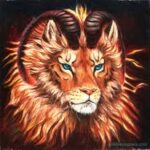My mom (the Wonderful Mother so often alluded to on this blog) always gets the latest gadgets on her phone. Recently she upgraded the camera and got the ability to take “burst photos.” That is, you press down the shutter button and the camera takes dozens of pictures per second until you take your finger off again. Naturally she wanted to try it out, and asked me to be a subject.
Since we were on our weekly bike ride at the time, she ended up photographing me riding my bicycle through a technical obstacle on one of the trails called The Notch. Usually we don’t take pictures of each other riding; it is too hard to get the timing right, and then the trail never looks as difficult in a picture as it does in person. But with her phone in “burst mode” she was able to simply select the picture that came out the best. However, what I found truly remarkable was the effect you got when you strung the photos together, like so:
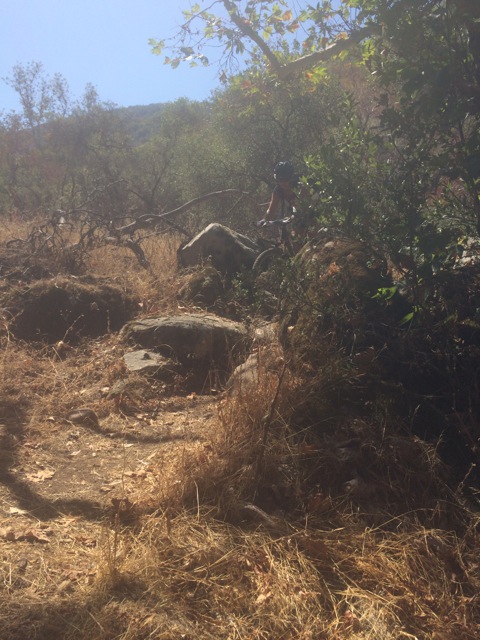
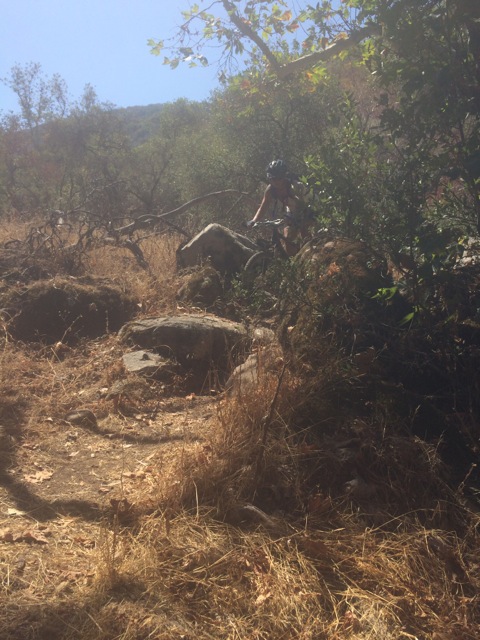
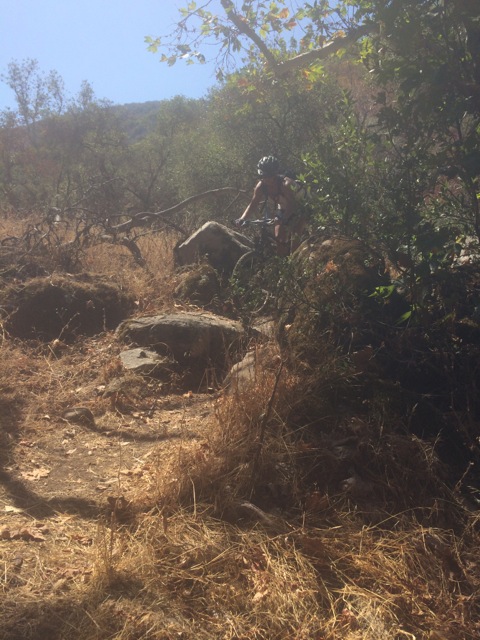
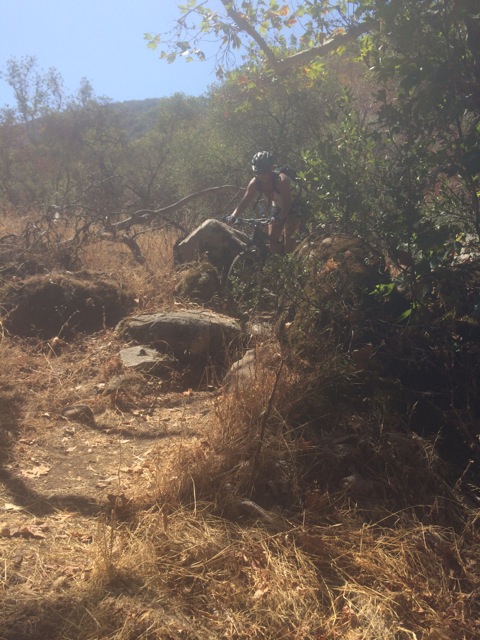
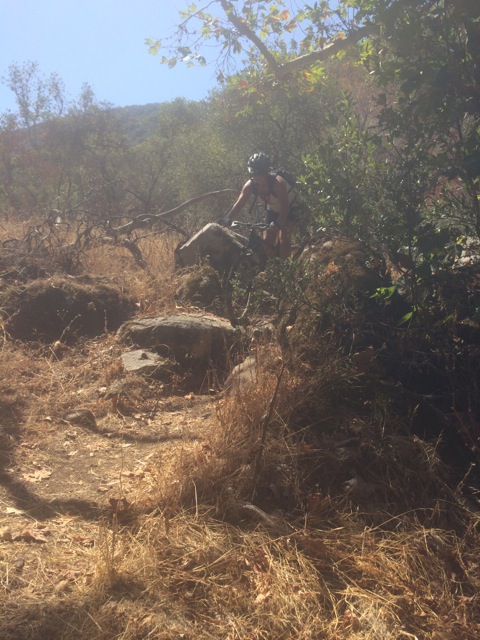
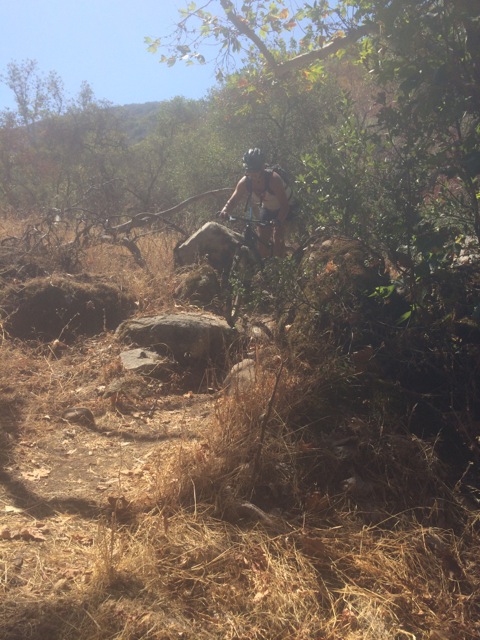
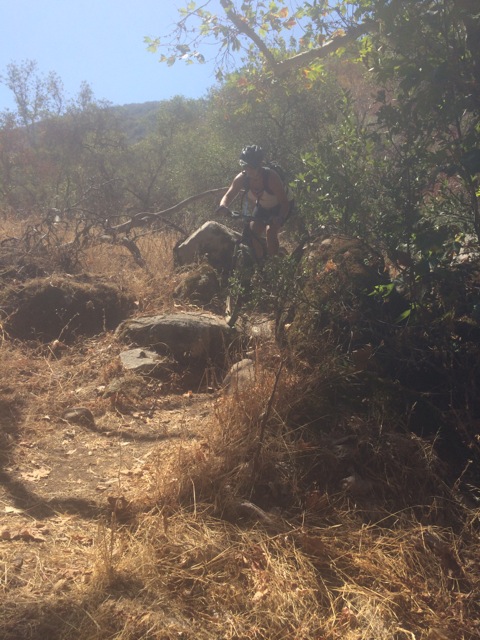
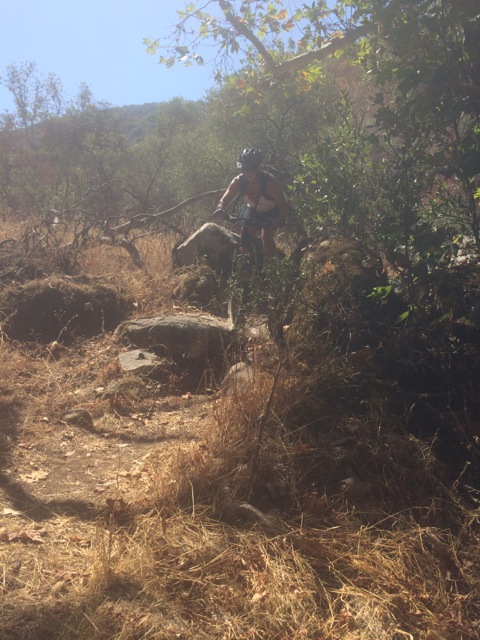
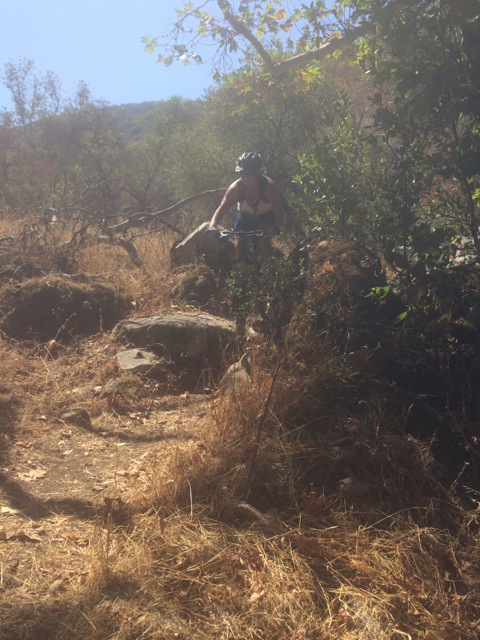
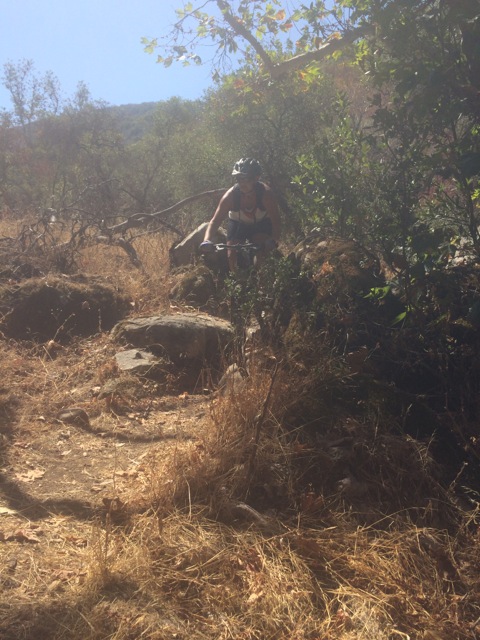
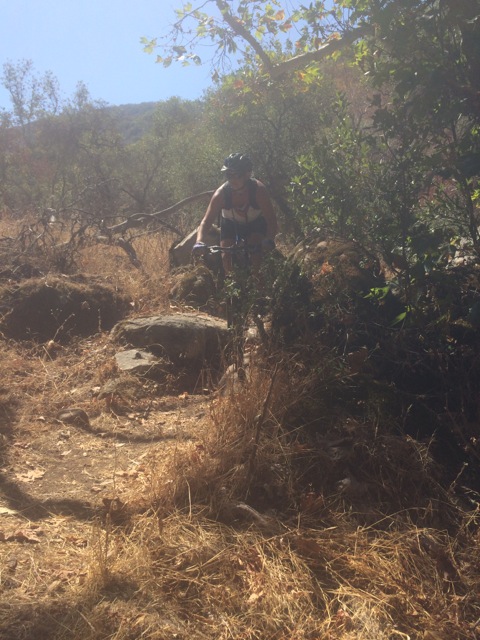
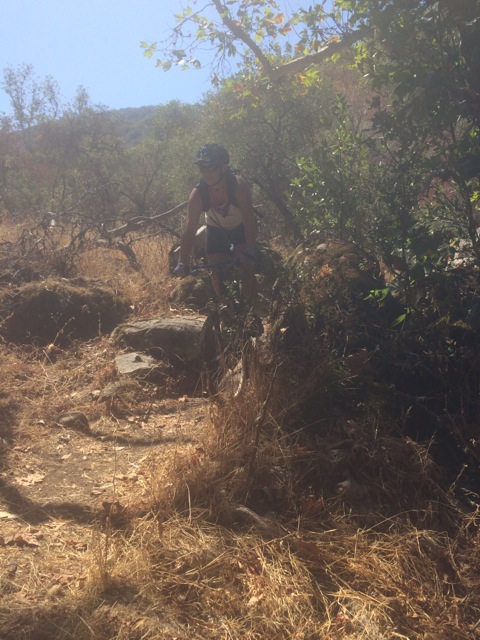
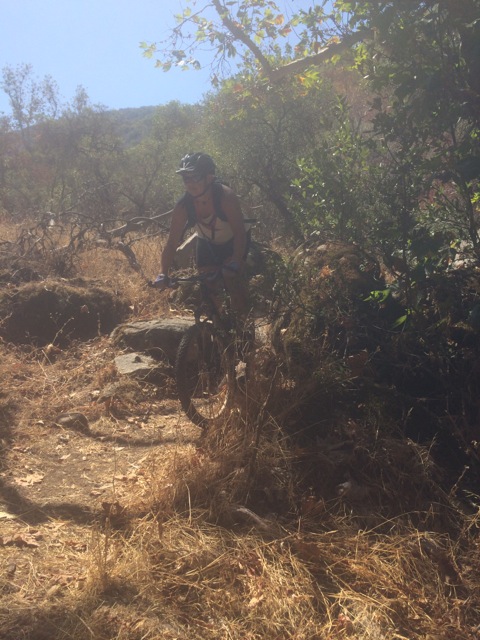
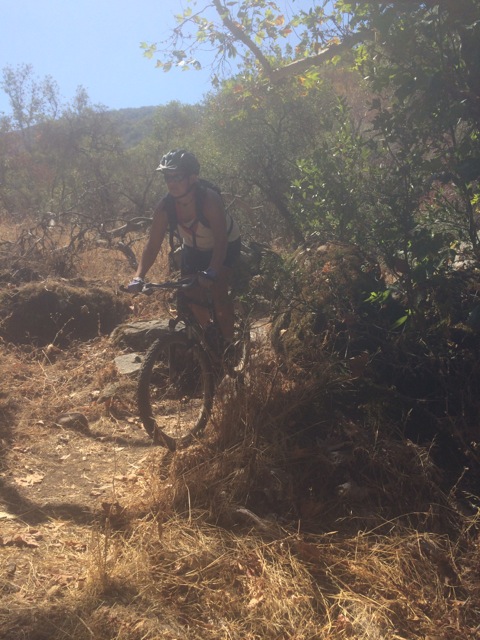
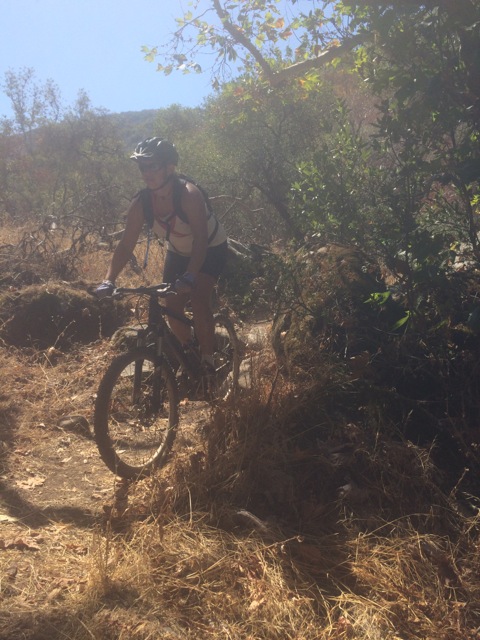
Firstly, as a mountain biker, it was interesting for me to get a chance to study my riding skills in such minute detail. In the moment, I do so many things automatically that they don’t register with my forebrain any more. Looking at the pictures, however, I was fascinated by the way I moved my body around, and how I changed from using both brakes, to my front brake, to my rear brake, and finally to no brakes at all. Another thing, and one that is perhaps of more general interest, is how you can track my focus.
Go back and look at the photos again, and see if you can’t spot the moment when there is a shift in my attention. I go from being zeroed in on a spot practically under my front tire, to looking up and away into the distance, even while my bicycle is still in the middle of a tight rocky obstacle.
This is because the Notch is a two-part obstacle. There is the Notch proper, which is exactly what it sounds like: two boulders bracket you on either side, with a third laid flat. This one ends in a steep drop-off—you do not want to ride over it—but there is a narrow notch just to the left wide enough for a single tire. However, if you try to ride it by putting your front tire there, because of the different tracks the front and back wheel take when you go around tight curves, this will cause your back wheel to catch on the rocks and your pedals and chainrings to bounce off the side of the rock—throwing you off and sometimes seriously damaging your bike. So instead you ride your front wheel out onto the flat rock (you remember, the one with the drop-off?) and then turn off it halfway out, let your front wheel drop about a foot vertically, thus allowing your rear wheel to ride in the narrow, smooth notch.
And after all that you have maybe three feet to collect yourself, and try to ride up and over some more rocks (off camera in the pictures, to the viewer’s left).
The only way to string these two elements together successfully, I have found, is to spend the minimum amount of time looking at the Notch. Then as soon as my front wheel drops (the timing here is very tricky, as not going far enough/going too far will result in a crash) I stop thinking about the Notch, even though I’m right in the middle of it, and start thinking about the rock pile coming up.
I developed this method of attention-shifting from riding horses. When riding horses, unlike bicycles, you have to think for two people. You and the horse. If your horse feels that you’re uncertain, they are less likely to do what you tell them. This can be particularly disastrous if, like me, you did a lot of jumping.
The first thing you learn when jumping a horse (other than wow that felt awesome!) is that you must be confident. If you don’t believe, with every shred of your being, that you and your horse are going over that jump, the horse will know. They will know, and realize that, hey, I don’t have to take that jump. I could… run to the side. Or stop completely.
You learn to focus when you jump horses. Focus hard enough for two brains. Then, when you move on to jumping courses, you learn to shift that focus—and quickly!
I ran into trouble in my early courses—I would swing wide coming off the first jump and miss my second one. At the time my trainer explained it to me like this:
“You’re still thinking about your last fence. You have to be thinking about your next fence as soon as your horse’s front feet hit the ground. While you’re still in the air. Let your horse worry about landing, only you know the course, you have to be thinking of the next fence.”
There’s a lot to think about when jumping a horse. Not only, oh my god look at the size of that thing are we really going over it? But there’s striding, leads, and whether your horse (like mine) wants to put her head down and have a good buck after landing a jump. That’s a lot to keep track of, and it was easy to get stuck in one moment. You get so focused on the first fence that you forget you have to change leads, make a hard right, and take another one right after.
We did a lot of tight courses. “Handy Hunters” my trainer called them. I learned to visualize the course in my head ahead of time, to begin looking at the next jump as soon as I’d achieved take off at the first one. Horses need a lot of focus to be ridden well, but there’s only so much mischief they can get up to while in the air. And they can (mostly) be trusted to land right-side up.
So I would focus on my fence up to the point of lift off, and then look to my next one. The difference, as I recall, was immediate and profound. Because horses listen to so much more than your voice and leg and the reins. They will read your body weight. They can tell, by feel, which way you’re looking. And if I was looking at our next fence when we landed, my horse knew that was where we were going.
When I took this training to my mountain bike it was almost laughably easy. Because a mountain bike can’t run out on you, or refuse, or spook at a funny looking stick. Suddenly, I only had to focus for myself, but because I’d trained to focus for me plus horse it meant that I subconsciously treated my own body like a horse. I refused to allow myself to doubt, to dally, to question. I made a judgement call on whether I could ride a certain thing, and if I thought I could ride it, I committed to it utterly. And I would stack up obstacles in my head, like a jumper course. As soon as I was through one section, I moved on to the next. I looked, and bike and body followed.
The result was that I rode a ton of things no one expected me to, and I didn’t crash very much (because I simply didn’t ride the stuff I didn’t think I could). I remember one ride in particular, back in 2003, when I was fifteen. My mother and I bumped into a real pro of a rider, and we took him down the hardest, most technical trail. His reaction (after having ridden everything and making it look easy) was to turn to my Wonderful Mother and say: “Your daughter has really good focus.”
Which I thought was funny at the time (doesn’t everyone really focus on riding technical singletrack?) but in retrospect I appreciate it more and more.
Because this focus, that I developed for jumping horses, that I’ve honed and refined riding trails that hikers have trouble with, has transferred again—this time into writing.
You hear a lot from writers about getting into a space where you’re not distracted. About taking away human contact, turning off the phone, getting off the internet. And all these are excellent and if you have difficulty focusing you should definitely try them.
But there is more you can do, I think, than simply remove distractions. You can also actively practice your focus. Learn how to blot out everything that is not crucial to the task at hand. Line yourself up and commit.
Not saying that nothing can distract me from writing. I got very distracted the other day because I was writing in a coffee shop (usually a place I find quite conducive to concentration) and two helicopter pilots sat down at the next table and started chatting about flying, rescue operations, flying in white-out zero visibility down the side of a mountain, landing their helicopters in between tree trunks with mere inches of clearance. That was pretty distracting—but worth it.
I’ve also written over five hundred words in rather less than an hour sitting on a hard bench at a car wash. It had been a hectic day, and I realized the only way I was going to make my word count was if I simply brought my laptop with me everywhere and any chance I got I would pop it open and write.
Which just goes to show, I think, that training can cross over and affect completely different aspects of your life. I also hope it offers encouragement to people who maybe have trouble focusing. Because one thing I want to make absolutely clear: I was not born with this. My ability to focus was something I had to learn. It is something I’ve practiced for years. And you can too.
You don’t even have to learn to jump horses or ride mountain bikes.
But that might help.
And as to the whole ability to switch focus in an instant, that has definitely come in handy for juggling many different projects, as I do.
Goldeen Ogawa is a writer, illustrator and cartoonist. She has been riding horses since she was three and a half, and mountain biking since she was twelve. Strangely, she has yet to write stories about either of them. You can email her at goldeenogawa@gmail.com or peck at her on Twitter @GrimbyTweets.
